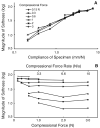Magnitude estimation of softness
- PMID: 18679665
- PMCID: PMC2574806
- DOI: 10.1007/s00221-008-1507-5
Magnitude estimation of softness
Abstract
The human capacity to estimate the magnitude of softness of silicone rubber disks of differing compliance was studied under experimental conditions that altered the mode of contact. Subjects were able to scale softness regardless of whether they (1) actively indented each specimen by tapping or pressing it with the finger pad, (2) received passive indentation of the finger pad by each specimen via a force controlled tactile stimulator, thus eliminating kinesthetic cues, or (3) actively indented each specimen with a stylus that was manipulated either by tapping with one finger, or held by two fingers in a precision grip, thereby removing tactile cues provided by direct mechanical contact between the finger pad and specimen. Ratings of softness were independent of moderate variations in peak compressional force and force-rate. Additionally, functions for scaling softness were affected by the mode of contact; the slopes of the functions were greater in the tasks with a complete complement of compliance cues. When subjects were asked to classify objects as either hard or soft, specimens were classified as soft if the compliance were greater than that of the human finger. This suggests that the classification of softness depends on whether the object conforms to the body, and that tactile information about the spatial profile of object deformation is sufficient for the magnitude scaling of softness. But typically, kinesthetic information about the magnitude of object displacement, along with contact vibratory cues is also used while judging softness especially in the absence of direct skin contact with the object when using a tool.
Figures








References
-
- Bisley JW, Goodwin AW, Wheat HE. Slowly adapting type I afferents from the sides and end of the finger respond to stimuli on the center of the fingerpad. J Neurophysiol. 2000;84:57–64. - PubMed
-
- Harper R, Stevens SS. Subjective hardness of compliant materials. Q J Exp Psychol. 1964;16:204–215.
-
- Katz D. The judgements of test bakers. A psychological study. Occup Psychol. 1938;12:139–148.
-
- Khalsa PS, Friedman RM, Srinivasan MA, Lamotte RH. Encoding of shape and orientation of objects indented into the monkey fingerpad by populations of slowly and rapidly adapting mechanoreceptors. J Neurophysiol. 1998;79:3238–3251. - PubMed
Publication types
MeSH terms
Grants and funding
LinkOut - more resources
Full Text Sources

